2018年高考英语全国I卷真题与解析
2018年高考英语(全国I卷)试题及参考答案(word版)
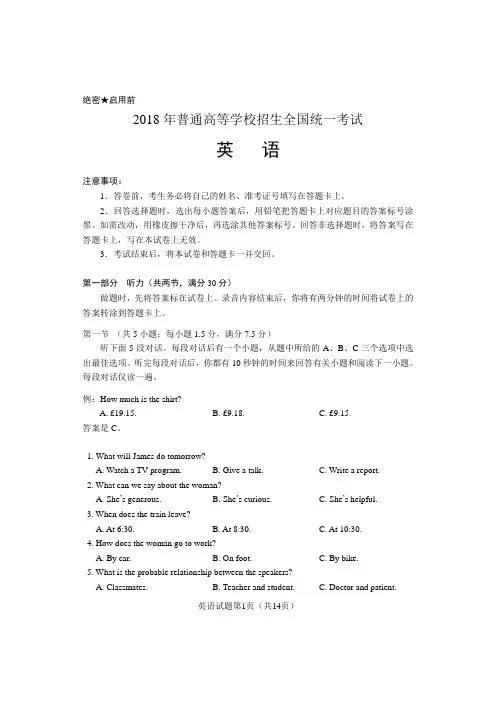
绝密★启用前2018年普通高等学校招生全国统一考试英语注意事项:1.答卷前,考生务必将自己的姓名、准考证号填写在答题卡上。
2.回答选择题时,选出每小题答案后,用铅笔把答题卡上对应题目的答案标号涂黑。
如需改动,用橡皮擦干净后,再选涂其他答案标号。
回答非选择题时,将答案写在答题卡上,写在本试卷上无效。
3.考试结束后,将本试卷和答题卡一并交回。
第一部分听力(共两节,满分30分)做题时,先将答案标在试卷上。
录音内容结束后,你将有两分钟的时间将试卷上的答案转涂到答题卡上。
第一节(共5小题;每小题1.5分,满分7.5分)听下面5段对话。
每段对话后有一个小题,从题中所给的A、B、C三个选项中选出最佳选项。
听完每段对话后,你都有10秒钟的时间来回答有关小题和阅读下一小题。
每段对话仅读一遍。
例:How much is the shirt?A. £19.15.B. £9.18.C. £9.15.答案是C。
1. What will James do tomorrow?A. Watch a TV program.B. Give a talk.C. Write a report.2. What can we say about the woman?A. She’s generous.B. She’s curious.C. She’s helpful.3. When does the train leave?A. At 6:30.B. At 8:30.C. At 10:30.4. How does the woman go to work?A. By car.B. On foot.C. By bike.5. What is the probable relationship between the speakers?A. Classmates.B. Teacher and student.C. Doctor and patient.英语试题第1页(共14页)第二节(共15小题;每小题1.5分,满分22.5分)听下面5段对话或独白。
2018年高考英语(全国I卷)试题及参考答案(word版)
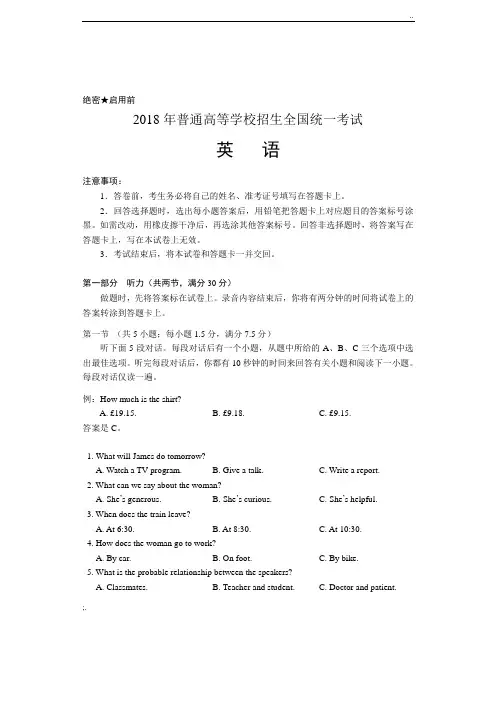
绝密★启用前2018年普通高等学校招生全国统一考试英语注意事项:1.答卷前,考生务必将自己的姓名、准考证号填写在答题卡上。
2.回答选择题时,选出每小题答案后,用铅笔把答题卡上对应题目的答案标号涂黑。
如需改动,用橡皮擦干净后,再选涂其他答案标号。
回答非选择题时,将答案写在答题卡上,写在本试卷上无效。
3.考试结束后,将本试卷和答题卡一并交回。
第一部分听力(共两节,满分30分)做题时,先将答案标在试卷上。
录音内容结束后,你将有两分钟的时间将试卷上的答案转涂到答题卡上。
第一节(共5小题;每小题1.5分,满分7.5分)听下面5段对话。
每段对话后有一个小题,从题中所给的A、B、C三个选项中选出最佳选项。
听完每段对话后,你都有10秒钟的时间来回答有关小题和阅读下一小题。
每段对话仅读一遍。
例:How much is the shirt?A. £19.15.B. £9.18.C. £9.15.答案是C。
1. What will James do tomorrow?A. Watch a TV program.B. Give a talk.C. Write a report.2. What can we say about the woman?A. She’s generous.B. She’s curious.C. She’s helpful.3. When does the train leave?A. At 6:30.B. At 8:30.C. At 10:30.4. How does the woman go to work?A. By car.B. On foot.C. By bike.5. What is the probable relationship between the speakers?A. Classmates.B. Teacher and student.C. Doctor and patient.;.第二节(共15小题;每小题1.5分,满分22.5分)听下面5段对话或独白。
2018年高考英语(全国I卷)试题及参考答案
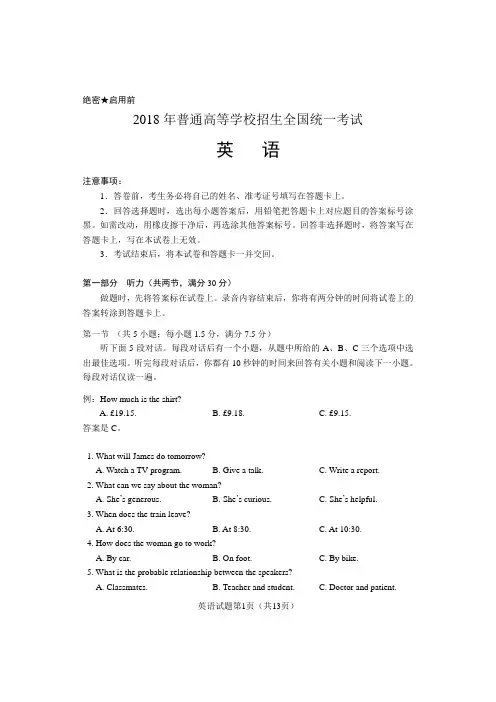
绝密★启用前2018年普通高等学校招生全国统一考试英语注意事项:1.答卷前,考生务必将自己的姓名、准考证号填写在答题卡上。
2.回答选择题时,选出每小题答案后,用铅笔把答题卡上对应题目的答案标号涂黑。
如需改动,用橡皮擦干净后,再选涂其他答案标号。
回答非选择题时,将答案写在答题卡上,写在本试卷上无效。
3.考试结束后,将本试卷和答题卡一并交回。
第一部分听力(共两节,满分30分)做题时,先将答案标在试卷上。
录音内容结束后,你将有两分钟的时间将试卷上的答案转涂到答题卡上。
第一节(共5小题;每小题1.5分,满分7.5分)听下面5段对话。
每段对话后有一个小题,从题中所给的A、B、C三个选项中选出最佳选项。
听完每段对话后,你都有10秒钟的时间来回答有关小题和阅读下一小题。
每段对话仅读一遍。
例:How much is the shirt?A. £19.15.B. £9.18.C. £9.15.答案是C。
1. What will James do tomorrow?A. Watch a TV program.B. Give a talk.C. Write a report.2. What can we say about the woman?A. She’s generous.B. She’s curious.C. She’s helpful.3. When does the train leave?A. At 6:30.B. At 8:30.C. At 10:30.4. How does the woman go to work?A. By car.B. On foot.C. By bike.5. What is the probable relationship between the speakers?A. Classmates.B. Teacher and student.C. Doctor and patient.英语试题第1页(共13页)第二节(共15小题;每小题1.5分,满分22.5分)听下面5段对话或独白。
2018年高考英语(全国I卷)试题及答案
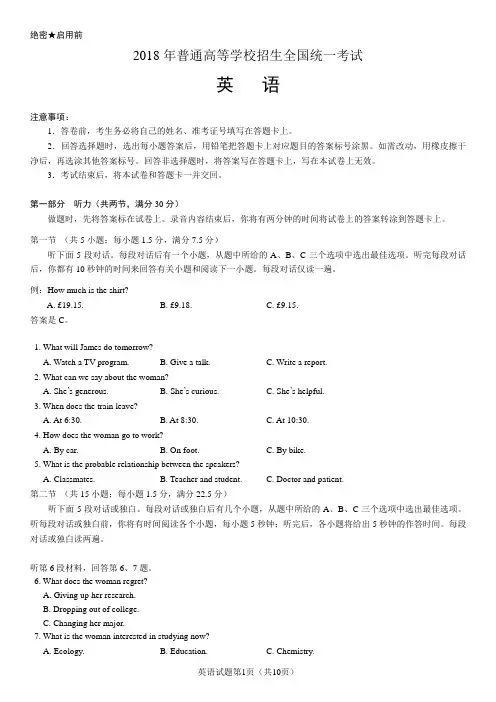
绝密★启用前2018年普通高等学校招生全国统一考试英语注意事项:1.答卷前,考生务必将自己的姓名、准考证号填写在答题卡上。
2.回答选择题时,选出每小题答案后,用铅笔把答题卡上对应题目的答案标号涂黑。
如需改动,用橡皮擦干净后,再选涂其他答案标号。
回答非选择题时,将答案写在答题卡上,写在本试卷上无效。
3.考试结束后,将本试卷和答题卡一并交回。
第一部分听力(共两节,满分30分)做题时,先将答案标在试卷上。
录音内容结束后,你将有两分钟的时间将试卷上的答案转涂到答题卡上。
第一节(共5小题;每小题1.5分,满分7.5分)听下面5段对话。
每段对话后有一个小题,从题中所给的A、B、C三个选项中选出最佳选项。
听完每段对话后,你都有10秒钟的时间来回答有关小题和阅读下一小题。
每段对话仅读一遍。
例:How much is the shirt?A. £19.15.B. £9.18.C. £9.15.答案是C。
1. What will James do tomorrow?A. Watch a TV program.B. Give a talk.C. Write a report.2. What can we say about the woman?A. She’s generous.B. She’s curious.C. She’s helpful.3. When does the train leave?A. At 6:30.B. At 8:30.C. At 10:30.4. How does the woman go to work?A. By car.B. On foot.C. By bike.5. What is the probable relationship between the speakers?A. Classmates.B. Teacher and student.C. Doctor and patient.第二节(共15小题;每小题1.5分,满分22.5分)听下面5段对话或独白。
2018年高考英语(全国I卷)试题及答案附听力原文和音频
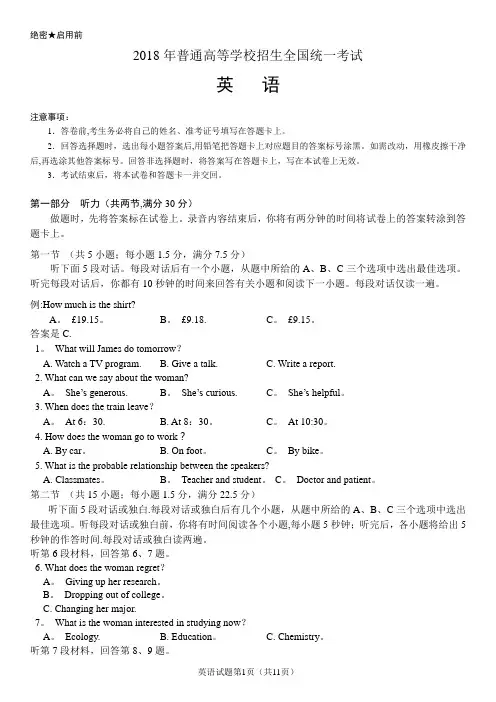
绝密★启用前2018年普通高等学校招生全国统一考试英语注意事项:1.答卷前,考生务必将自己的姓名、准考证号填写在答题卡上。
2.回答选择题时,选出每小题答案后,用铅笔把答题卡上对应题目的答案标号涂黑。
如需改动,用橡皮擦干净后,再选涂其他答案标号。
回答非选择题时,将答案写在答题卡上,写在本试卷上无效。
3.考试结束后,将本试卷和答题卡一并交回。
第一部分听力(共两节,满分30分)做题时,先将答案标在试卷上。
录音内容结束后,你将有两分钟的时间将试卷上的答案转涂到答题卡上。
第一节(共5小题;每小题1.5分,满分7.5分)听下面5段对话。
每段对话后有一个小题,从题中所给的A、B、C三个选项中选出最佳选项。
听完每段对话后,你都有10秒钟的时间来回答有关小题和阅读下一小题。
每段对话仅读一遍。
例:How much is the shirt?A。
£19.15。
B。
£9.18. C。
£9.15。
答案是C.1。
What will James do tomorrow?A. Watch a TV program.B. Give a talk.C. Write a report.2. What can we say about the woman?A。
She’s generous.B。
She’s curious.C。
She’s helpful。
3. When does the train leave?A。
At 6:30. B. At 8:30。
C。
At 10:30。
4. How does the woman go to work?A. By car。
B. On foot。
C。
By bike。
5. What is the probable relationship between the speakers?A. Classmates。
B。
Teacher and student。
C。
Doctor and patient。
2018年高考英语全国I卷试题+答案(word 文档)
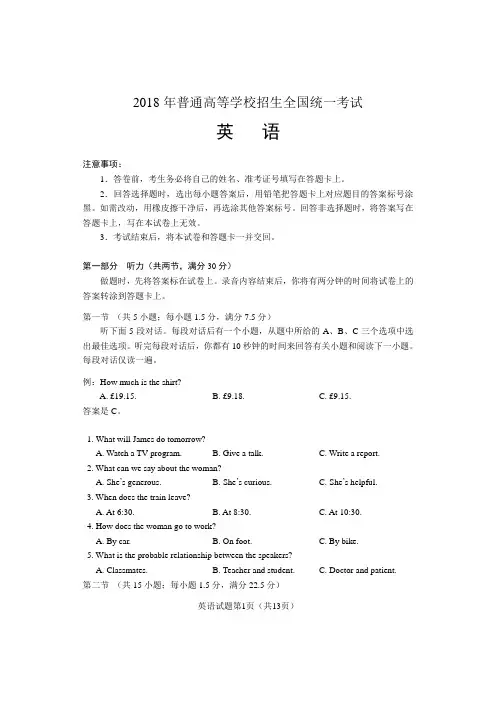
2018年普通高等学校招生全国统一考试英语注意事项:1.答卷前,考生务必将自己的姓名、准考证号填写在答题卡上。
2.回答选择题时,选出每小题答案后,用铅笔把答题卡上对应题目的答案标号涂黑。
如需改动,用橡皮擦干净后,再选涂其他答案标号。
回答非选择题时,将答案写在答题卡上,写在本试卷上无效。
3.考试结束后,将本试卷和答题卡一并交回。
第一部分听力(共两节,满分30分)做题时,先将答案标在试卷上。
录音内容结束后,你将有两分钟的时间将试卷上的答案转涂到答题卡上。
第一节(共5小题;每小题1.5分,满分7.5分)听下面5段对话。
每段对话后有一个小题,从题中所给的A、B、C三个选项中选出最佳选项。
听完每段对话后,你都有10秒钟的时间来回答有关小题和阅读下一小题。
每段对话仅读一遍。
例:How much is the shirt?A. £19.15.B. £9.18.C. £9.15.答案是C。
1. What will James do tomorrow?A. Watch a TV program.B. Give a talk.C. Write a report.2. What can we say about the woman?A. She’s generous.B. She’s curious.C. She’s helpful.3. When does the train leave?A. At 6:30.B. At 8:30.C. At 10:30.4. How does the woman go to work?A. By car.B. On foot.C. By bike.5. What is the probable relationship between the speakers?A. Classmates.B. Teacher and student.C. Doctor and patient.第二节(共15小题;每小题1.5分,满分22.5分)英语试题第1页(共13页)听下面5段对话或独白。
2018高中高考英语全国1卷附包括答案解析及简单解析.doc
范文范例参考绝密★启封前2018年普通高等学校招生全国统一考试(新课标I)英语注意事项:1.答题前,先将自己的姓名、准考证号填写在试题卷和答题卡上,并将准考证号条形码粘贴在答题卡上的指定位置。
用2B 铅笔将答题卡上试卷类型 A 后的方框涂黑。
2.选择题的作答:每小题选出答案后,用2B 铅笔把答题卡上对应题目的答案标号涂黑,写在试题卷、草稿纸和答题卡上的非答题区域均无效。
3.非选择题的作答:用签字笔直接答在答题卡上对应的答题区域内。
写在试题卷、草稿纸和答题卡上的非答题区域均无效。
4.考试结束后,请将本试题卷和答题卡一并上交。
第Ⅰ卷第一部分听力(共两节,满分30分)做题时,现将答案标在试卷上,录音内容结束后,你将有两分钟的时间将试卷上的答案转涂到答题卡上。
第一节(共 5小题;每小题 1.5分,满分7.5分)听下面 5段对话,每段对话后有一个小题。
从题中所给的A,B,C三个选项中选出最佳选项,并标在试卷的相应位置。
听完每段对话后,你都有10秒钟的时间来回答有关小题和阅读下一小题。
每段对话仅读一遍。
例: How much is the shirt?A. £ 19.15B. £ 9.18C. £ 9.15答案是 C 。
1.What are the speakers talking about?A. Having a birthday party.B.Doing someexercise.C.Getting Lydia a gift2.What is the woman going to do?A. Help the man.B. Take a bus.C. Get a camera3.What does the woman suggest the man do?A. Tell Kate to stop.B.Call Kate,s friends.C.Stay away from Kate.WORD格式整理***范文范例参考5.Where does the conversation probably take place?A. In a wine shop.B. In a supermarket.C. In a restaurant.6.What does the woman mean?A. Keep the window closed.B. Go out for fresh air.C. Turn on the fan.听第 6 段材料,回答第6、 7 题。
2018年高考英语(全国I卷)试题及答案
绝密★启用前2018年普通高等学校招生全国统一考试英语注意事项:1.答卷前,考生务必将自己的姓名、准考证号填写在答题卡上。
2.回答选择题时,选出每小题答案后,用铅笔把答题卡上对应题目的答案标号涂黑。
如需改动,用橡皮擦干净后,再选涂其他答案标号。
回答非选择题时,将答案写在答题卡上,写在本试卷上无效。
3.考试结束后,将本试卷和答题卡一并交回。
第一部分听力(共两节,满分30分)做题时,先将答案标在试卷上。
录音内容结束后,你将有两分钟的时间将试卷上的答案转涂到答题卡上。
第一节(共5小题;每小题1.5分,满分7.5分)听下面5段对话。
每段对话后有一个小题,从题中所给的A、B、C三个选项中选出最佳选项。
听完每段对话后,你都有10秒钟的时间来回答有关小题和阅读下一小题。
每段对话仅读一遍。
例:How much is the shirt?A. £19.15.B. £9.18.C. £9.15.答案是C。
1. What will James do tomorrow?A. Watch a TV program.B. Give a talk.C. Write a report.2. What can we say about the woman?A. She’s generous.B. She’s curious.C. She’s helpful.3. When does the train leave?A. At 6:30.B. At 8:30.C. At 10:30.4. How does the woman go to work?A. By car.B. On foot.C. By bike.5. What is the probable relationship between the speakers?A. Classmates.B. Teacher and student.C. Doctor and patient.第二节(共15小题;每小题1.5分,满分22.5分)听下面5段对话或独白。
2018高考英语(全国I卷)真题及参考答案
2018年普通高等学校招生全国统一考试英语注意事项:1.答卷前,考生务必将自己的姓名、准考证号填写在答题卡上。
2.回答选择题时,选出每小题答案后,用铅笔把答题卡上对应题目的答案标号涂黑。
如需改动,用橡皮擦干净后,再选涂其他答案标号。
回答非选择题时,将答案写在答题卡上,写在本试卷上无效。
3.考试结束后,将本试卷和答题卡一并交回。
第一部分听力(共两节,满分30分)做题时,先将答案标在试卷上。
录音内容结束后,你将有两分钟的时间将试卷上的答案转涂到答题卡上。
第一节(共5小题;每小题1.5分,满分7.5分)听下面5段对话。
每段对话后有一个小题,从题中所给的A、B、C三个选项中选出最佳选项。
听完每段对话后,你都有10秒钟的时间来回答有关小题和阅读下一小题。
每段对话仅读一遍。
例:How much is the shirt?A. £19.15.B. £9.18.C. £9.15.答案是C。
1. What will James do tomorrow?A. Watch a TV program.B. Give a talk.C. Write a report.2. What can we say about the woman?A. She’s generous.B. She’s curious.C. She’s helpful.3. When does the train leave?A. At 6:30.B. At 8:30.C. At 10:30.4. How does the woman go to work?A. By car.B. On foot.C. By bike.5. What is the probable relationship between the speakers?A. Classmates.B. Teacher and student.C. Doctor and patient.第二节(共15小题;每小题1.5分,满分22.5分)听下面5段对话或独白。
2018年全国统一高考英语试卷(新课标Ⅰ)(含解析版)
2018年全国统一高考英语试卷(新课标Ⅰ卷)第二部分阅读理解(共两节,满分40分)第一节(共15小题;每小题2分,满分30分)阅读下列短文,从每题所给的A、B、C和D四个选项中,选出最佳选项。
AWashington,D.C.Bicycle ToursCherry Blossom Bike Tour in Washington,D.C.Duration TourThis small group bike tour is a fantastic way to see a world-famous cherry trees with beautiful flowers of Washington,D.C.Your guide will provide a history lesson about the trees and the famous monuments where they blossom.Reserve your spot before availability—the cherry blossoms—disappear!Washington Capital Monuments Bicycle TourDuration:3hours(4miles)Join a guided bike tour and view some of the most popular monuments in Washington,D.C.Explore the monuments and memorials on the National Mall as your guide shares unique facts and history at each stop.Guided tour includes bike,helmet,cookies and bottled water.Capital City Bike Tour In Washington,D.C.Duration:3hoursMorning or Afternoon,this bike tour is the perfect tour for D.C.newcomers and locals looking to experience Washington,D.C.in a healthy way with minimum effort.Knowledgeable guides will entertain you with the most,interesting stories about Presidents,Congress,memorials,and fortable bikes and a smooth tour route(路线)make cycling between the sites fun and relaxing.Washington Capital Sites at Night Bicycle TourDuration:3hours(7miles)Join a small group bike tour for an evening of exploration in the heart of Washington,D.C.Get up close to the monuments and memorials as your bike the sites of Capitol Hill and the National Mall. Frequent stops are made for photo taking as your guide offers unique facts and history.Tour includes bike,helmet,and bottled water.All riders are equipped with reflective vests and safety lights.21.Which tour do you need to book in advance?A.Cherry Blossom like Tour in Washington,D.C.B.Washington capital Monuments Bicycle Tour.C.Capital City Bike Tour in Washington,D.C.D.Washington Capital Sites at Night Bicycle Tour.22.What will you do on the Capital City Bike Tour?A.Meet famous people.B.Go to a national park.C.Visit well-known museums.D.Enjoy interesting stories.23.Which of the following does the bicycle tour at night provide?A.City maps.B.Cameras.C.MealsD.Safety lightsBGood Morning Britain’s Susanna Reid is used to grilling guests on the sofa every morning,but she is cooking up a storm in her latest role—showing families how to prepare delicious and nutritious meals on a tight budget.In Save Money:Good Food,she visits a different home each week and with the help of chef Matt Tebbutt offers top tips on how to reduce food waste,while preparing recipes for under£5per family a day. And the Good Morning Britain presenter says she’s been able to put a lot of what she’s leant into practice in her own home,preparing meals for sons,Sam,14,Finn,13,and Jack,11.“We love Mexican churros,so I buy them on my phone from my local Mexican takeaway restaurant,”she explains.“I pay£5for a portion(一份),but Matt makes them for26p a portion,because they are flour,water,sugar and oil.Everybody can buy takeaway food,but sometimes we’re not aware how cheaply we can make this food ourselves.”The eight-part series(系列节自),Save Money:Good Food,follows in the footsteps of ITV’s Save Money:Good Health,which gave viewers advice on how to get value from the vast range of health products on the market.With food our biggest weekly household expense,Susanna and Matt spend time with a differentfamily each week.In tonight’s Easter special they come to the aid of a family in need of some delicious inspiration on a budget.The team transforms the family’s long weekend of celebration with less expensive but still tasty recipes.24.What do we know about Susanna Reid?A.She enjoys embarrassing her guests.B.She has started a new programme.C.She dislikes working early in the morning.D.She has had a light budget for her family.25.How does Matt Tebbutt help Susanna?A.He buys cooking materials for her.B.He prepares food for her kids.C.He assists her in cooking matters.D.He invites guest families for her.26.What does the author intend to do in paragraph4?A.Summarize the previous paragraphs.B.Provide some advice for the readers.C.Add some background information.D.Introduce a new topic for discussion.27.What can be a suitable title for the text?A.Keeping Fit by Eating SmartB.Balancing Our Daily DietC.Making yourself a Perfect ChefD.Cooking Well for LessCLanguages have been coming and going for thousands of years,but in recent times there has been less coming and a lot more going.When the the world was still populated by hunter-gatherers,small, tightly knit(联系)groups developed their own patterns of speech independent of each other.Some language experts believe that10,000years ago,when the world had just five to ten million people,they spoke perhaps12,000languages between them.Soon afterwards,many of those people started settling down to become farmers,and their languages too became more settled and fewer in number.In recent centres,trade,industrialisation,the development of the nation-state and the spread of universal compulsory education.Especially glbalisation and better communications in the past few decades,all have caused many Languages to disappear,and dominant languages such as English.Spanish and Chinese are increasingly taking over.At present,the world has about6,800languages.The distribution of these languages is hugely uneven.The general rule is that mild zones have relatively few languages.Often spoken by many people while hot,wet zones have lots,often spoken by small numbers.Europe has only around200Languages: the Americas about1,000.Africa2,400;and Asia and the Pacific perhaps3,200,of which Papua New Guinea alone accounts for well over800.The median number(中位数)of speakers is a mere6.000, which means that half the worlds languages are spoken by fewer people than that.Already well over400of the total of6,800languages are close to extinction(消亡),with only a few elderly speakers left.Pick,at random,Busuu in Cameroon(eight remaining speakers),Chiapaneco in Mexico(150).Lipan Apache in the United States(two or three)or Wadjigu in Australia(one,with a question-mark):none of these seems to have much chance of survival.28.What can we infer about languages in huntergatherer times?A.They developed very fast.B.They were large in number.C.They had similar patters.D.They were closely connected29.Which of the following best explains“dominant”underlined in paragraph2?plex.B.Advanced.C.Powerful.D.Modem.30.How many languages are spoken by less than6,000people at present?A.About6,800.B.About3,400.C.About2,400.D.About1,200.31.What is the min idea of the text?A.New languages will be created.B.Peoples lifestyles are reflected in languagesC.Human development results in fewer languagesD.Geography determines language evolution.DWe may think we’re a culture that gets rid of our worn technology at the first sight of something shiny and new,but a new study shows that we keep using our old devices(装置)well after they go out of style.That’s bad news for the environment—and our wallets—as these outdated devices consume much more energy than the newer ones that do the same things.To figure out how much power these devices are using,Callie Babbitt and her colleagues at the Rochester Institute of Technology in New York tracked the environmental costs for each product throughout its life—from when its minerals are mined to when we stop using the device.This method provided a readout for how home energy use has evolved since the early1990s.Devices were grouped by generation—Desktop computers,basic mobile phones,and box-set TVs defined1992.Digital cameras arrived on the scene in1997.And MP3players,smart phones,and LCD TVs entered homes in2002, before tablets and e-readers showed up in2007.As we accumulated more devices,however,we didn’t throw out our old ones.“The living-room television is replaced and gets planted in the kids’room,and suddenly one day,you have a TV in every room of the house,”said one researcher.The average number of electronic devices rose from four per household in1992to13in2007.We’re not just keeping these old devices—we continue to use them. According to the analysis of Babbitt’s team,old desktop monitors and box TVs with cathode ray tubes are the worst devices with their energy consumption and contribution to greenhouse gas emissions(排放)more than doubling during the1992to2007window.So what’s the solution(解决方案)?The team’s data only went up to2007,but the researchers also explored what would happen if consumers replaced old products with new electronics that serve more than one function,such as a tablet for word processing and TV viewing.They found that more on-demand entertainment viewing on tablets instead of TVs and desktop computers could cut energy consumption by 44%.32.What does the author think of new devices?A.They are environment-friendly.B.They are no better than the old.C.They cost more to use at home.D.They go out of style quickly.33.Why did Babbitt’s team conduct the research?A.To reduce the cost of minerals.B.To test the life cycle of a product.C.To update consumers on new technology.D.To find out electricity consumption of the devices.34.Which of the following uses the least energy?A.The box-set TV.B.The tablet.C.The LCD TV.D.The desktop computer.35.What does the text suggest people do about old electronic devices?A.Stop using them.B.Take them apart.C.Upgrade them.D.Recycle them.第二节(共5小题;每小题2分,满分10分)根据短文内容,从短文后的选项中选出能填入空白处的最佳选项。
- 1、下载文档前请自行甄别文档内容的完整性,平台不提供额外的编辑、内容补充、找答案等附加服务。
- 2、"仅部分预览"的文档,不可在线预览部分如存在完整性等问题,可反馈申请退款(可完整预览的文档不适用该条件!)。
- 3、如文档侵犯您的权益,请联系客服反馈,我们会尽快为您处理(人工客服工作时间:9:00-18:30)。
2018 年高考英语全国I 卷真题第二部分阅读理解(共两节,满分40 分)第一节(共15 小题;每小题2 分,满分30 分)阅读下列短文,从每题所给的A、B、C 和D 四个选项中,选出最佳选项。
AWashington, D.C. Bicycle Tours Cherry Blossom BikeTour in Washington, D.C.Duration: 3 hoursThis small group bike tour is a fantastic way to see the world-famous cherry trees with beautiful flowers of Washington, D.C. Your guide will provide a history lesson about the treesand the famous monuments where they blossom. Reserve your spot before availability–and the cherry blossoms–disappear! Washington Capital Monuments Bicycle TourDuration: 3 hours (4 miles)Join a guided bike tour and view some of the most popular monuments in Washington, D.C. Explore the monuments and memorials on the National Mallas your guide shares unique facts and history at each stop. Guided tour includes bike, helmet, cookies and bottled water.Capital City Bike Tour in Washington, D.C.Duration: 3 hoursMorning or Afternoon, this bike tour is the perfect tour for D.C. newcomers and locals looking to experience Washington, D.C. in a healthy way with minimum effort. Knowledgeable guides will entertain you with the most interesting stories about Presidents, Congress, memorials, and parks. Comfortable bikes and a smooth tour route (路线) make cycling between the sites fun and relaxing.Washington Capital Sites at Night Bicycle TourDuration: 3 hours (7 miles)Join a small group bike tour for an evening of exploration in the heart of Washington, D.C. Get up close to the monuments and memorials as you bike the sites of Capitol Hill and the National Mall. Frequent stops are made for photo taking as your guide offers unique facts and history. Tour includes bike, helmet, and bottled water. All riders are equipped with reflective vests and safety lights.21. Which tour do you need to book in advance?A. Cherry Blossom Bike Tour in Washington, D.C.B. Washington Capital Monuments Bicycle Tour.C. Capital City Bike Tour in Washington,D.C.D. Washington Capital Sites at Night Bicycle Tour.22. What will you do on the Capital City Bike Tour?A. Meet famous people.B. Go to a national park.C. Visit well-known museums.D. Enjoy interesting stories.23. Which of the following does the bicycle tour at night provide?A. City maps.B. Cameras.C. Meals.D. Safety lights.BGood Morning Britain’s Susanna Reid is used to grilling guests on the sofaevery morning, but she is cooking up a storm in her latest role — showingfamilies how to prepare delicious and nutritious meals on a tight budget.In Save Money: Good Foo,dshe visits a different home each week and withthe help of chef Matt Tebbutt offers top tips on how to reduce food waste, whilepreparing recipes for under 5 per£family a day. And the Good Morning Britainpresenter says she ’s been able to put a lot of what she ’s learnt into practice in he own home, preparing meals for sons, Sam, 14, Finn, 13, and Jack, 11.“Welove Mexican churros, so I buy them on my phone from my localMexican takeaway restaurant, ” she explains. “I p a a y p o r tio5n f(o一r 份), burMatt makes them for 26p a portion, because they are flour, water, sugar and oil.Everybody can buy takeaway food, but sometimes we ’re not aware how cheaplywe can make this food ourselves. ”The eight-part series (系列节目), Save Money: Good Food, follows in thefootsteps of ITV S a v s e Money: Good Health, which gave viewers advice on howto get value from the vast range of health products on the market.With food our biggest weekly household expense, Susanna and Matt spendtime with a differe nt family each week. In tonight ’s Easter special they come tothe aid of a family in need of some delicious inspiration on a budget. The teamtransforms the family ’s long weekend of celebration with less expensive but stilltasty recipes.24. What do we know about Susanna Reid?A. She enjoys embarrassing her guests.B. She has started a new programme.C. She dislikes working early in the morning.D. She has had a tight budget for her family.25. How does Matt Tebbutt help Susanna?A. He buys cooking materials for her.B. He prepares food for her kids.C. He assists her in cooking matters.D. He invites guest families for her.26. What does the author intend to do in paragraph 4?A. Summarize the previous paragraphs.B. Provide some advice for the readers.C. Add some background information.D. Introduce a new topic for discussion.27. What can be a suitable title for the text?A. Keeping Fit by Eating SmartB. Balancing Our Daily DietC. Making Yourself a Perfect ChefD. Cooking Well for LessCLanguages have been coming and going for thousands of years, but inrecent times there has been less coming and a lot more going. When the worldwas still populated by hunter-gatherers, small, tightly knit ( 联系) groups developed their own patterns of speech independent of each other. Some language experts believe that 10,000 years ago, when the world had just five toten million people, they spoke perhaps 12,000 languages between them.Soon afterwards, many of those people started settling down to become farmers, and their languages too became more settled and fewer in number. Inrecent centuries, trade, industrialisation, the development of the nation-state andthe spread of universal compulsory education, especially globalisation and better communicationsin the past few decades,all have caused many languages to disappear, and dominant languagessuch as English, Spanish and Chinese are increasingly taking over.At present, the world has about 6,800 languages. The distribution of these languages is hugely uneven. The general rule is that mild zones have relativelyfew languages, often spoken by many people, while hot, wet zones have lots, often spoken by small numbers. Europe has only around 200 languages; the Americasabout 1,000; Africa 2,400; and Asia and the Pacific perhaps 3,200, of whichPapua New Guinea alone accounts for well over 800. The median number 中(位数) of speakers is a mere 6,000, which means that half the world ’s languages are spoken by fewer people than that.Already well over 400 of the total of 6,800 languages are close to extinction(消亡), with only a few elderly speakers left. Pick, at random, Busuu in Cameroon (eight remaining speakers), Chiapaneco in Mexico (150), LipanApache in the United States (two or three) or Wadjigu in Australia (one, with aquestion-mark): none of these seems to have much chance of survival.28. What can we infer about languages in hunter-gatherer times?A. They developed very fast.B. They were large in number.C. They had similar patterns.D. They were closely connected.29. Which of the following best explains “dominant” underlined in paragraph 2?A. Complex.B. Advanced.C. Powerful.D. Modern.30. How many languages are spoken by less than 6,000 people at present?A. About 6,800.B. About 3,400.C. About 2,400.D. About 1,200.31. What is the main idea of the text?A. New languages will be created.B. People ’s lifestyles are reflected in languages.C. Human development results in fewer languages.D. Geography determines language evolution.DWe may think we ’re a culture that gets rid of our worn technology at the firstsight of something shiny and new, but a new study shows that we keep using ourold devices (装置) well after they go out of style. That’sbad news for the environment— and our wallets— as these outdated devices consume much moreenergy than the newer ones that do the same things.To figure out how much power these devices a re using, Callie Babbitt andher colleagues at the Rochester Institute of Technology in New York tracked the environmental costs for each product throughout its life— from when itsminerals are mined to when we stop using the device. This method provided areadout for how home energy use has evolved since the early 1990s. Devices were grouped by generation. Desktop computers, basic mobile phones, and box-setTVs defined 1992. Digital cameras arrived on the scene in 1997. And MP3players, smart phones, and LCD TVs entered homes in 2002, before tablets ande-readers showed up in 2007.As we accumulated more devices, however, we didn ’t throw out our old ones. “The living-room television is replaced and gets planted in the kids ’ room, and suddenly one day, you have a TV in every room of the house,”said one researcher. The average number of electronic devices rose from four per household in 1992 to 13 in 2007. We ’re not just keeping these old d e w v i e c e s—continue to use them. According to the analysis of Babbitt ’s team, old desktop monitors and box TVs with cathode ray tubes are the worst devices with their energy consumption and contribution to greenhouse gas emissions排(放) morethan doubling during the 1992 to 2007 window.So what’s the solutio解n决( 方案)? The team ’s data only went up to 2007, butthe researchers also explored what would happen if consumersreplaced oldproducts with new electronics that serve more than one function, such as a tabletfor word processing and TV viewing. They found that more on-demand entertainment viewing on tablets instead of TVs and desktop computers couldcut energy consumption by 44%.32. What does the author think of new devices?A. They are environment-friendly.B. They are no better than the old.C. They cost more to use at home.D. They go out of style quickly.33. Why did Babbitt ’s team conduct the research?A. To reduce the cost of minerals.B. To test the life cycle of a product.C. To update consumers on new technology.D. To find out electricity consumption of the devices.34. Which of the following uses the least energy?A. The box-set TV.B. The tablet.C. The LCD TV.D. The desktop computer.35. What does the text suggest people do about old electronic devices?A. Stop using them.B. Take them apart.C. Upgrade them.D. Recycle them.第二节(共5 小题;每小题2 分,满分10 分)根据短文内容,从短文后的选项中选出能填入空白处的最佳选项。
